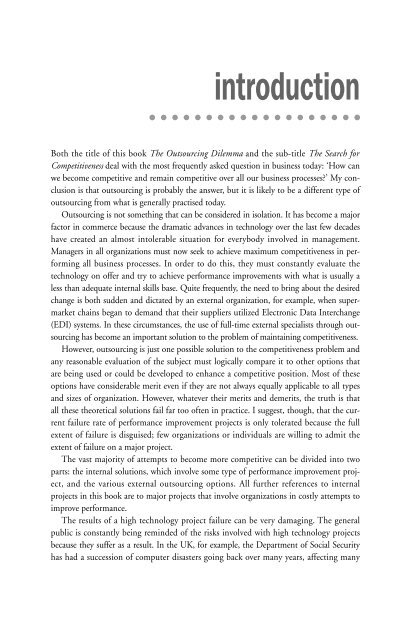The Outsourcing Dilemma - The Search for Competitiveness.pdf
The Outsourcing Dilemma - The Search for Competitiveness.pdf
The Outsourcing Dilemma - The Search for Competitiveness.pdf
Create successful ePaper yourself
Turn your PDF publications into a flip-book with our unique Google optimized e-Paper software.
introduction<br />
Both the title of this book <strong>The</strong> <strong>Outsourcing</strong> <strong>Dilemma</strong> and the sub-title <strong>The</strong> <strong>Search</strong> <strong>for</strong><br />
<strong>Competitiveness</strong> deal with the most frequently asked question in business today: ‘How can<br />
we become competitive and remain competitive over all our business processes’ My conclusion<br />
is that outsourcing is probably the answer, but it is likely to be a different type of<br />
outsourcing from what is generally practised today.<br />
<strong>Outsourcing</strong> is not something that can be considered in isolation. It has become a major<br />
factor in commerce because the dramatic advances in technology over the last few decades<br />
have created an almost intolerable situation <strong>for</strong> everybody involved in management.<br />
Managers in all organizations must now seek to achieve maximum competitiveness in per<strong>for</strong>ming<br />
all business processes. In order to do this, they must constantly evaluate the<br />
technology on offer and try to achieve per<strong>for</strong>mance improvements with what is usually a<br />
less than adequate internal skills base. Quite frequently, the need to bring about the desired<br />
change is both sudden and dictated by an external organization, <strong>for</strong> example, when supermarket<br />
chains began to demand that their suppliers utilized Electronic Data Interchange<br />
(EDI) systems. In these circumstances, the use of full-time external specialists through outsourcing<br />
has become an important solution to the problem of maintaining competitiveness.<br />
However, outsourcing is just one possible solution to the competitiveness problem and<br />
any reasonable evaluation of the subject must logically compare it to other options that<br />
are being used or could be developed to enhance a competitive position. Most of these<br />
options have considerable merit even if they are not always equally applicable to all types<br />
and sizes of organization. However, whatever their merits and demerits, the truth is that<br />
all these theoretical solutions fail far too often in practice. I suggest, though, that the current<br />
failure rate of per<strong>for</strong>mance improvement projects is only tolerated because the full<br />
extent of failure is disguised; few organizations or individuals are willing to admit the<br />
extent of failure on a major project.<br />
<strong>The</strong> vast majority of attempts to become more competitive can be divided into two<br />
parts: the internal solutions, which involve some type of per<strong>for</strong>mance improvement project,<br />
and the various external outsourcing options. All further references to internal<br />
projects in this book are to major projects that involve organizations in costly attempts to<br />
improve per<strong>for</strong>mance.<br />
<strong>The</strong> results of a high technology project failure can be very damaging. <strong>The</strong> general<br />
public is constantly being reminded of the risks involved with high technology projects<br />
because they suffer as a result. In the UK, <strong>for</strong> example, the Department of Social Security<br />
has had a succession of computer disasters going back over many years, affecting many















